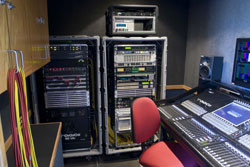DiGiCo SD10B Serves As Digital Hub For NEP Hawaii Broadcast Truck

HONOLULU—A DiGiCo SD10B is the newest edition to NEP’s Hawaii-based Supershooter 3 mobile broadcast truck.
The expanding 53' trailer outfit with modular workstations and removable equipment racks is a versatile broadcast facility that can serve as either a mobile production truck or as a fly-pack unit.
Under the direction of NEP’s General Manager on Oahu, Rodney Kobayakawa, the truck will be used by Oceanic Time Warner Cable to cover mostly high school and University of Hawaii and high school sporting events, as well as music, comedy and entertainment productions across the islands. With the addition of the DiGiCo console, now these productions can affordably offer surround sound and high-definition quality audio.
“Initially, we had one standard-def and one HD truck but wanted to get more business,” said Kobayakawa, who has been NEP’s local GM since 1994. “The concept was to get a truck that could be ‘de-rigged,’ and also used as a portable fly-pack. That would give us enough versatility to go virtually anywhere. We tried to do it on the cheap, and I had originally spec’d another digital console, but the design was all being done in Pittsburgh at NEP headquarters by Joseph Signorino, vice president of NEP Systems Integration, who insisted on doing it right.”
Kobayakawa said Signorino selected the DiGiCo SD10B after seeing it at NAB, choosing it over the Calrec consoles favored by NEP Hawaii because it had to be small, portable and affordable. His choice was confirmed by Hawaiian Pat Ku from Rhema Services is a major DiGiCo production outfit, who “only had great things to say about the console.” He admits, “In the beginning it was a bit of a challenge because a lot of the operators were not used to a reprogrammable, flying fader type of console—not a full-blown digital computer map board.”
“We still have yet to use it in the fly-pack mode, but we’ve built a frame—again, Joe Sig’s hallmark design—so the DiGiCo board can unbolt easily and fit into a modified shipping case. Now everything from monitors to cables is modularized and can be accommodated into three-four flight cases,” Kobayakawa said of the truck’s busy schedule.
“Having everything embedded, audio and video—we have 16 embedder inputs and de-embedder outputs—enables us to take 16 video feeds and de-embed the eight channels of audio associated with that video feed,” he said.
Kobayakawa says they then use the audio console to mix, and the router embeds it in the video as indicated “so they can record both audio and eight channels of audio on one coaxial cable, along with the video.”
The MADI audio monitors supply monitoring for everybody except the main speakers in the production room, which are fed from the console, which has its own speakers, the Neumann KH120s.
“The console feeds the router, which is embedded with the program video from the switcher, and then we provide an audio embedded HD feed to the uplink. But we also can provide AES feeds and analog feeds to the uplink if they so desire,” Kobayakawa said. “There’s also a CD player, a DigiCart and an iPod rig. The talent microphones, IFBs and Intercom use a fiber-based, IP-driven system by Lance Designs and are processed to a Cat5 cable using a system called CobraNet which is similar to Ethernet and converted to optical fiber, which comes back to the truck and is converted back to CobraNet/Ethernet and then goes to the Lance system.”
Kobayakawa explained the stage box is inside the console room, and they use the MADI in the video router section and convert it to AES, while the DiGiCo SD10B is the main console and everything goes through it.”
“I come from a live sound background and had heard great things about the console,” said Sean Rowbottom, the main engineer/technical liaison at NEP Hawaii. “I love the capabilities of the MADI, the AES, and since our truck is all AES and MADI and everything’s embedded—we hardly have any analog besides what comes out of the rack itself.”
The professional video industry's #1 source for news, trends and product and tech information. Sign up below.
